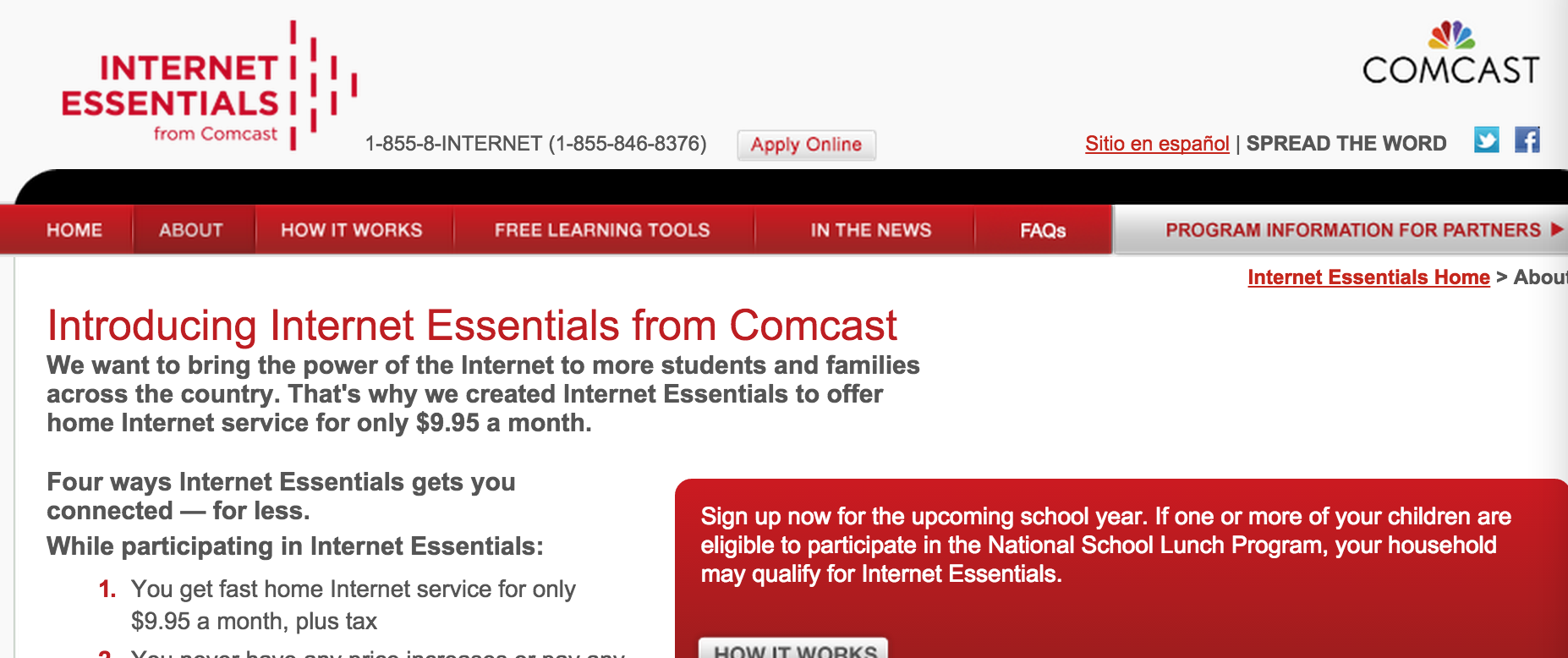Comcast Doesn’t Want to Improve its ‘Internet Essentials’ Program for Low-Income Consumers
 With Comcast’s $45 billion acquisition of Time Warner Cable nearing the finish line, you’d think the company would be willing to do something as insignificant as make promises to improve its broadband program for low-income users. You’d be wrong.
With Comcast’s $45 billion acquisition of Time Warner Cable nearing the finish line, you’d think the company would be willing to do something as insignificant as make promises to improve its broadband program for low-income users. You’d be wrong.
As part of its deal to acquire NBCUniversal back in 2011, Comcast convinced regulators that it would create a broadband program for lower-income Americans to help them get online in a world where Internet access is increasingly important.
Since that program, dubbed Internet Essentials, launched, it’s been criticized by consumer advocates as little more than window-dressing that erects too many barriers to entry and provides too few benefits for subscribers.
Late last week, an administrative judge for the California Public Utility Commission issued a proposed approval [PDF] of the merger in the state, but brought up concerns about some possible issues — including Internet Essentials — that should be hammered out before the deal is done.
“We are… persuaded by evidence of Comcast’s Internet Essentials program’s weak performance in closing the digital divide in California and fulfilling universal service goals,” reads the report, “and thus do not view it as a mitigating factor without additional conditions.”
The CPUC points out that Comcast has committed to offer Essentials to qualifying customers it acquires from TWC, but notes that the company, “has made no promises regarding expanded IE eligibility, concrete enrollment goals for IE, faster download and upload speeds for IE recipients, continued provision of standalone broadband Internet access at reasonable rates, or the construction of additional Internet access points in underserved communities.”
The report makes some recommendations to mitigate Essentials-related problems. Not only does the CPUC want Comcast to extend the existing service to qualifying California consumers, but also to increase the minimum broadband speed to 10Mbps downstream — twice the current rate for Essentials, but still far below the 25Mbps definition recently adopted by the FCC.
The commission also asks for Comcast to provide Essentials customers with a wireless router free of cost, which only makes sense since Comcast uses company-supplied routers to create public WiFi hotspots.
Those are easy. It’s the next bunch of recommendations that likely ruffled the peacock feathers at Kabletown HQ.
The report asks Comcast to revise the eligibility for Essentials so that it includes all households in its service territory “having household incomes equal to 150% of the federal poverty level or less.”
Currently, Comcast only offers Essentials to households with at least one child enrolled in the school lunch program. Critics have noted that this omits the elderly, the childless, and adults with grown children who are no less harmed by not being able to access the Internet.
Another suggestion that undoubtedly irked Comcast is the proposed requirement that Comcast “enroll at least 45% of eligible households in Internet Essentials within two years of the effective date of the parent company merger.”
See, Comcast has loved making a big show about launching Internet Essentials programs in various cities; it’s not unheard of to see some Comcast bigwig shaking the hands of a mayor or city council leader when touting how great Essentials will be.
But compelling the company to actually go out there and openly alert consumers to the availability of Essentials means Comcast would have to spend money on more than a small-scale press event.
In his response to the mixed news from the CPUC, Comcast’s Merger Whisperer, Exec. VP David Cohen acknowledges that “a number of the conditions” recommended by the Commission “are ones that will benefit consumers and the company can work with.”
However, warns Cohen, some of the conditions “could potentially prevent the full benefits of this transaction being realized by Californians, and create a more intrusive regulatory regime where innovative services could be hampered rather than helped.”
Read: They are things we don’t wanna do.
Interestingly enough, the only example he calls out involves Essentials.
“[T]he penetration rates and time frames suggested by the conditions are simply unattainable under market conditions, especially with populations that have been slowest to adopt broadband,” argues Cohen, ignoring the reason that maybe these people haven’t adopted broadband is because it costs too much.
He doesn’t seem to believe that it’s possible to attain the 45% penetration rate (even though the CPUC offers a way for Comcast to reach a lower level of Essentials adoption).
“Nationally, across our footprint though we only have a penetration rate of 40% of homes we pass taking our broadband service. In California, it’s about the same,” he writes. “And that’s after we’ve spent billions marketing and advertising those services.”
Maybe Comcast shouldn’t have spent billions in advertising, especially since, as it has repeatedly pointed out in the last year, it has no competition from other pay-TV providers in most of its markets.
And perhaps people have been avoiding signing up for Comcast broadband service because they read stories about horrendous customer service and then how customers are labeled things like “A**shole” and “dummy” on their cable bills — or fired from their jobs — when they complain.
Want more consumer news? Visit our parent organization, Consumer Reports, for the latest on scams, recalls, and other consumer issues.

